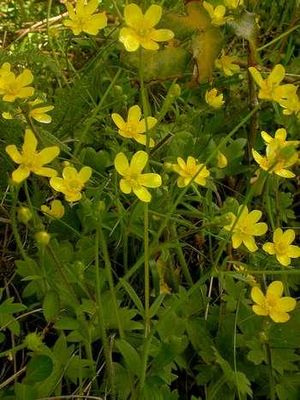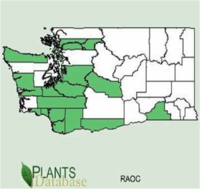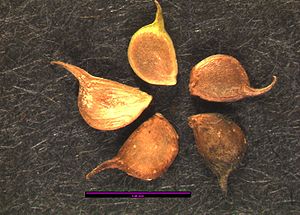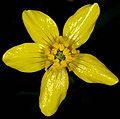Difference between revisions of "Ranunculus occidentalis"
(→Uses) (Tag: VisualEditor) |
|||
| Line 28: | Line 28: | ||
Leaves: Basal leaves long-petiolate, the blades 2-3.5 cm. long, deeply 3-lobed, the lobes with coarse, rounded teeth; cauline leaves alternate, more deeply dissected, reduced upward to the entire bracts. | Leaves: Basal leaves long-petiolate, the blades 2-3.5 cm. long, deeply 3-lobed, the lobes with coarse, rounded teeth; cauline leaves alternate, more deeply dissected, reduced upward to the entire bracts. | ||
| − | Flowers: Pedicels single-flowered, up to 10 cm. long; sepals 5, greenish or pinkish-tinged, spreading but sharply reflexed at mid-length, hairy, early-deciduous; petals 5, yellow, oblong, 9-12 mm. long and nearly half as broad; nectary scale broadly wedge-shaped, 1 mm. long, the lateral margins free ¾ their length; receptacle ovoid; stamens 30-60; pistils 10-20. | + | Flowers: Pedicels single-flowered, up to 10 cm. long; sepals 5, greenish or pinkish-tinged, spreading but sharply reflexed at mid-length, hairy, early-deciduous; petals 5, yellow, oblong, 9-12 mm. long and nearly half as broad; nectary scale broadly wedge-shaped, 1 mm. long, the lateral margins free ¾ their length; receptacle ovoid; stamens 30-60; pistils 10-20. |
| − | + | ||
| − | + | ||
===Bloom Period=== | ===Bloom Period=== | ||
| − | April-June <ref name=" | + | April-June, right before and among the Camas.<ref name=":0">Bowcutt, F., & Hamman, Sarah. (2016). ''Vascular plants |
| + | of the South Sound prairies'' (First ed.). Olympia, Washington: The Evergreen | ||
| + | State College Press.</ref> | ||
===Distribution=== | ===Distribution=== | ||
| − | West of the Cascades, Alaska to California, and east to the Blue mountains in Oregon. | + | West of the Cascades, Alaska to California, and east to the Blue mountains in Oregon. |
[[File:RAOC distribution.png|200px|thumb|right|''Ranunculus occidentalis'' distribution]] | [[File:RAOC distribution.png|200px|thumb|right|''Ranunculus occidentalis'' distribution]] | ||
===Habitat=== | ===Habitat=== | ||
| − | Moist to well-drained soil, | + | Moist to well-drained soil, meadows and open woods, mostly west Cascades, Alaska to California, east to Alberta and northeast Oregon. |
| − | + | ||
===Uses=== | ===Uses=== | ||
| − | + | Ecological: Adult Mardon Skippers (''Polites mardon'') feed on the nectar of ''R. occidentalis,'' among other flowers. <ref name=":0" /> | |
| − | First Nations: The juice from the flowers | + | |
| + | First Nations: The juice from the flowers used as a poison. Seeds cooked and used as piñole either on their own or mixed with other seeds. The seed must be parched in order to remove an acrid principle.<ref>Native American Ethnobotany Database. Retrieved from <nowiki>http://naeb.brit.org/uses/search/?string=ranunculus+occidentalis</nowiki></ref> | ||
===Propagation=== | ===Propagation=== | ||
| Line 86: | Line 86: | ||
</gallery> | </gallery> | ||
===References=== | ===References=== | ||
| − | < | + | <references /> |
Revision as of 10:43, 9 May 2020
Common name: Western buttercup
Abbreviation Code (Codon): RAOC
| " | Ranunculus occidentalis | |
|---|---|

| |
| Ranunculus occidentalis | |
| " | Scientific classification | |
| Kingdom: | Plantae |
| Subkingdom: | Tracheobionta |
| Phylum: | Spermatophyta |
| Subphylum: | Magnoliophyta |
| Class: | Magnoliopsida |
| Subclass: | Magnoliidae |
| Order: | Ranunculales |
| Family: | Ranunculaceae |
| Genus: | Ranunculus |
| Species: | Ranunculus occidentalis Nutt. |
Contents
Description
General: Stiff-hairy perennial from slender fibrous roots, the 1-several stems erect, usually hollow, freely branched, 1.5-4 dm. tall.
Leaves: Basal leaves long-petiolate, the blades 2-3.5 cm. long, deeply 3-lobed, the lobes with coarse, rounded teeth; cauline leaves alternate, more deeply dissected, reduced upward to the entire bracts.
Flowers: Pedicels single-flowered, up to 10 cm. long; sepals 5, greenish or pinkish-tinged, spreading but sharply reflexed at mid-length, hairy, early-deciduous; petals 5, yellow, oblong, 9-12 mm. long and nearly half as broad; nectary scale broadly wedge-shaped, 1 mm. long, the lateral margins free ¾ their length; receptacle ovoid; stamens 30-60; pistils 10-20.
Bloom Period
April-June, right before and among the Camas.[1]
Distribution
West of the Cascades, Alaska to California, and east to the Blue mountains in Oregon.
Habitat
Moist to well-drained soil, meadows and open woods, mostly west Cascades, Alaska to California, east to Alberta and northeast Oregon.
Uses
Ecological: Adult Mardon Skippers (Polites mardon) feed on the nectar of R. occidentalis, among other flowers. [1]
First Nations: The juice from the flowers used as a poison. Seeds cooked and used as piñole either on their own or mixed with other seeds. The seed must be parched in order to remove an acrid principle.[2]
Propagation
Seed
Seed sample from: 2011
Average Measurement: 3.5 x 2.6 x 1
Measurement Range: L: 3 - 4, W: 2 - 3, D: 0.75 - 1.25
Features
Shape: Seed surface is rounded, tapering off to a style that is opposite hilum, but off centered from it.
Additional structures: Style generally 1 – 2 mm long.
Color: Seeds are brown, tending toward a lighter brown or tan at edges of seed surface.
Surface: Seeds are papillose with some small ridges around the surface edges.
Latitudinal Cross Section: elliptical ![]()
Longitudinal Cross Section: elliptical ![]()
Basic Explanations and Assumptions:
The dimensions for the seeds are length x width x depth. The location of the hilum is used as the base of the seed, and the length is measured from hilum to the opposite apex. Where a style is present, the length is measured from the hilum to the bottom of the style. Width is measured at a right angle to the length at the widest part. Depth is measured at a right angle to the intersection of height and width lines.
Measurements included are the mean average for each measurement of ten separate seeds.
All measurements in millimeters unless otherwise noted.





